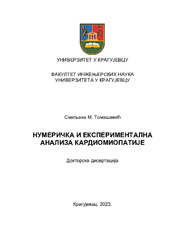Numerička i eksperimentalna analiza kardiomiopatije
Numerical and experimental analysis of cardiomyopathy
| dc.contributor.advisor | Filipović, Nenad | |
| dc.contributor.other | Isailović, Velibor | |
| dc.contributor.other | Jovičić, Gordana | |
| dc.contributor.other | Velicki, Lazar | |
| dc.contributor.other | Saveljić, Igor | |
| dc.creator | Tomašević, Smiljana | |
| dc.date.accessioned | 2024-04-24T14:01:35Z | |
| dc.date.available | 2024-04-24T14:01:35Z | |
| dc.date.issued | 2023 | |
| dc.identifier.uri | http://eteze.kg.ac.rs/application/showtheses?thesesId=8722 | |
| dc.identifier.uri | https://fedorakg.kg.ac.rs/fedora/get/o:1681/bdef:Content/download | |
| dc.identifier.uri | https://nardus.mpn.gov.rs/handle/123456789/22432 | |
| dc.description.abstract | Iako su sprovedene brojne kliničke studije i postavljene smernice dobre kliničke prakse, nedostaci u razumevanju mehanizama napredovanja kardiomiopatije, stratifikaciji pacijenata u nisko- i visoko-rizične grupe, kao i u određivanju i praćenju dejstva terapija za svakog pojedinačnog pacijenta i dalje postoje. Praćenje progresije kardiomiopatije i pridružene aortopatije, kao i efekata lekova na miokard, naglašava potrebu za razvojem novih metoda za bolje razumevanje srčanih funkcija. Data disertacija obuhvata analizu hipertrofične i dilatativne kardiomiopatije, kao i pridruženih bolesti koje se odnose na različite stepene aortne stenoze i utiču na srčanu hipertrofiju. Kreirani su različiti trodimenzionalni (3D) parametarski modeli leve srčane komore, kao i 3D modeli realne anatomske geometrije aortnog korena, i celog srca. Deo podataka iz sprovedene kliničke studije i eksperimentalnih istraživanja kardiomiopatije iskorišćeni su za razvoj i validaciju numeričkih modela, stratifikaciju rizika od progresa kardiomiopatije, kao i za modeliranje dejstva različitih grupa lekova na srčanu funkciju. Kompjuterske simulacije sa 3D parametarskim modelima leve srčane komore izvedene su pomoću spregnutih mikro- i makromodela, primenom metode konačnih elemenata i fluid-solid interakcijom. Interakcije lekova sa kardiomiocitima određene su u okviru eksperimentalnih istraživanja srčanog tkiva, a rezultati su implementirani u spregnuti višeskalni model kako bi se odredio efekat različitih grupa lekova na 3D model leve komore srca. Implementirani su aktivni i pasivni modeli mišića. Na modelima realne anatomske geometrije simuliran je uticaj različitih stepena aortne stenoze na odzive fluida i solida, i diskutovana je njena povezanost sa hipertrofijom srca i aortopatijom. Predstavljene metode i rezultati kompjuterskih simulacija za različite tipove kardiomiopatije i pridruženih kardiovaskularnih bolesti imaće značajan uticaj na kliničke smernice i buduće pravce lečenja pacijenata. | sr |
| dc.description.abstract | Although numerous clinical studies have been conducted and guidelines of good clinical practice have been established, there are lacks in understanding the mechanisms of cardiomyopathy progression, stratifying patients into low- and high-risk groups, as well as determining and monitoring the effects of therapies for each individual patient. Monitoring of cardiomyopathy progression and associated aortopathy, as well as the effects of drugs on the myocardium, highlights the need for development of new methods to better understand cardiac functions. The presented dissertation includes the analysis of hypertrophic and dilated cardiomyopathy, as well as associated diseases related to different degrees of aortic stenosis affecting cardiac hypertrophy. Different three-dimensional (3D) parametric models of the left heart ventricle are created, as well as the 3D patient-specific models of aortic root and the whole heart. Part of the data from the conducted clinical and experimental studies of cardiomyopathy are used for the development and validation of numerical models, risk stratification of cardiomyopathy, as well as for modeling the effects of different drug groups on cardiac function. Computational simulations including 3D parametric models of the left heart ventricle are performed using coupled micro- and macromodels, employing the finite element method and fluid-solid interaction. Drugs interactions with cardiomyocytes are determined within the experimental studies of heart tissue, while the results are implemented in a coupled multiscale model to determine the effects of different drug groups on a 3D model of the left heart ventricle. Active and passive muscle models are implemented. The influence of different aortic stenosis severities on fluid and solid behaviour was simulated on patientspecific models, whereas its association with cardiac hypertrophy and aortopathy was discussed. The presented methods and results of computational simulations for different types of cardiomyopathies and associated cardiovascular diseases will have a significant impact on clinical guidelines and future directions of patients’ treatments. | en |
| dc.format | application/pdf | |
| dc.language | sr | |
| dc.publisher | Универзитет у Крагујевцу, Факултет инжењерских наука | sr |
| dc.rights | openAccess | en |
| dc.rights.uri | https://creativecommons.org/licenses/by-sa/4.0/ | |
| dc.source | Универзитет у Крагујевцу | sr |
| dc.subject | kompjuterske simulacije, metoda konačnih elemenata, kardiomiopatija, eksperimentalna istraživanja, aortna stenoza, parametarski 3D modeli, modeli realne anatomske geometrije | sr |
| dc.subject | computational simulations, finite element method, experimental studies, cardiomyopathy, aortic stenosis, parametric 3D models, patient-specific models | en |
| dc.title | Numerička i eksperimentalna analiza kardiomiopatije | sr |
| dc.title.alternative | Numerical and experimental analysis of cardiomyopathy | en |
| dc.type | doctoralThesis | |
| dc.rights.license | BY-SA | |
| dc.identifier.fulltext | http://nardus.mpn.gov.rs/bitstream/id/160799/Doctoral_thesis_15479.pdf | |
| dc.identifier.rcub | https://hdl.handle.net/21.15107/rcub_nardus_22432 |


